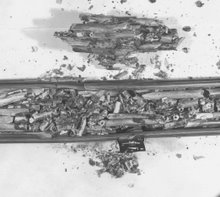Here is a worthwhile reference. I'll study it.
Dear Bob,
I undusted some of my earlier irritations and came across the following (from the saame time I was doing my battle with NRC):
TEST RESULTS
Following the uncovering and dryout during the coolant boilaway,the rods heated at a rate of 2 to 5 K/s until peak cladding temperatures of 1700 K were attained,at which time the autocatalytic oxidation reaction resulted in a temperature excursion (at a rate of 10 to 50 K/s) and hydrogen generation. Peak local cladding temperaturesare estimated to have exceeded-2600 K, based on information from thermocouples on the outside of the bundle liner.
The high-temperature oxidation reaction began at the 2.4- to 3.04-m elevation and formed a localized burn front that moved quickly downward as far as the 1.2-m elevation and then steadily upward. The burn front reached the top end caps (3.80m) and ceased 15 min before the end of the test. The oxidation reaction consumed 75% of the total Zircaloy or almost 100% of the Zircaloy in the path of the burn front. The remaining 25% of the Zircaloy was always
below or near the bundle water level. The amount of hydrogen generated was 300±30 g, close to the total conversion of the 1.26-g/s makeup coolant flow within the 45-min high-temperature period. The hydrogen flow fluctuated during the 45-min high-temperature period in response to similar fluctuations (10% to 20% relative)in the bundle coolant flow. The peak hydrogen flow was 190 mg/s, which corresponded to an oxidation power of 28 kW.
FULL-LENGTH HIGH-TEMPERATURE
SEVERE FUEL DAMAGE TEST #5
D. D. Lanning
N. J. Lombardo
W. K. Hensley
D. E. Fitzsimmons
J. K. Hartwell @ EG&G-Idaho
F. E. Panisko
April 1988 – Completion Date
September 1993 – Publication Date
Prepared for
U. S. Nuclear Regulatory Commission
Under U.S. Department of Energy
Contract DE-ACO6-76RLO1830
PNL—6540
http://www.osti.gov/energycitations/product.biblio.jsp?query_id=2&page=0&osti_id=10188341
Pls. Note: „Post-test visual examination of one side of the fuel bundle revealed no massive relocation and flow blockage; however, rundown of molten cladding was evident." – contradicts to the above description of authors that the cladding burned off above the water level with a rate allowed by water flow.
Thursday, August 28, 2008
Subscribe to:
Post Comments (Atom)

No comments:
Post a Comment